The last round of this season’s UEFA Champions League group stage brought us an “Orthodox brothers” duel between Olympiacos and Red Star Belgrade, whose fans are in a really good and close relationship. Although the game was interwoven with the fandom note of cheering from the stands, it meant the world for both of the teams as the winner would secure the third spot and would go to the Europa League, as the hosts did at the end by winning it 1-0
Vladan Milojević’s men had their chances and were in a better position before the match as they needed just not to lose if they wanted to participate in the “European spring”, but they didn’t manage to save their net and ended losing all hopes. This tactical analysis will show you how the home team got better of their “brothers” using their tactics in this highly physical duel.
Lineups
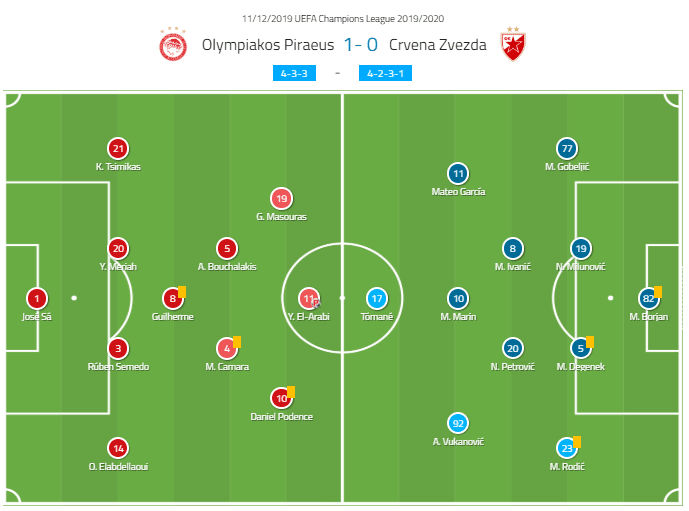
Pedro Martins went into the game with his 4-3-3 formation with his side being forced to play it in a possessional manner. His main catalysts were the midfield trio made of Guilherme, Andreas Bouchalackis and Mady Camara who controlled the central zone of the field and were the key for their creation. Daniel Podence and Giorgos Masouras provided the single striker Youssef el-Arabi with support and were the attacking force of their side along with him.
The away team’s coach set his team in their usual 4-2-3-1 tactics with a clear defensive attitude they nurtured throughout the whole season. They relied mostly on their tight block that went through a lot of transformations with youngster Njegoš Petrović and Mirko Ivanić in control of it in the midfield. Marko Marin was once again their string between the offence and defence and the guy who caused most problems for the opposition.
Red Star’s out-of-possession play
In beforehand of the duel, Olympiacos was clearly set as the team who will need to chase the goal if they want to go through the Europa League so it wasn’t a surprise that they had a possessional dominance through the whole 90 minutes. The visitors came to Pireaus with the idea of dense defending, as that was their best quality in this campaign, and they tended to be disciplined in moving without the ball.
Their main shape in those situations was 4-4-2 block with its variations, but they used it from the start in the same way they used it in some past matches. That was the structure with which they are most familiar and it was easiest for them to transform in it from the start of the match.
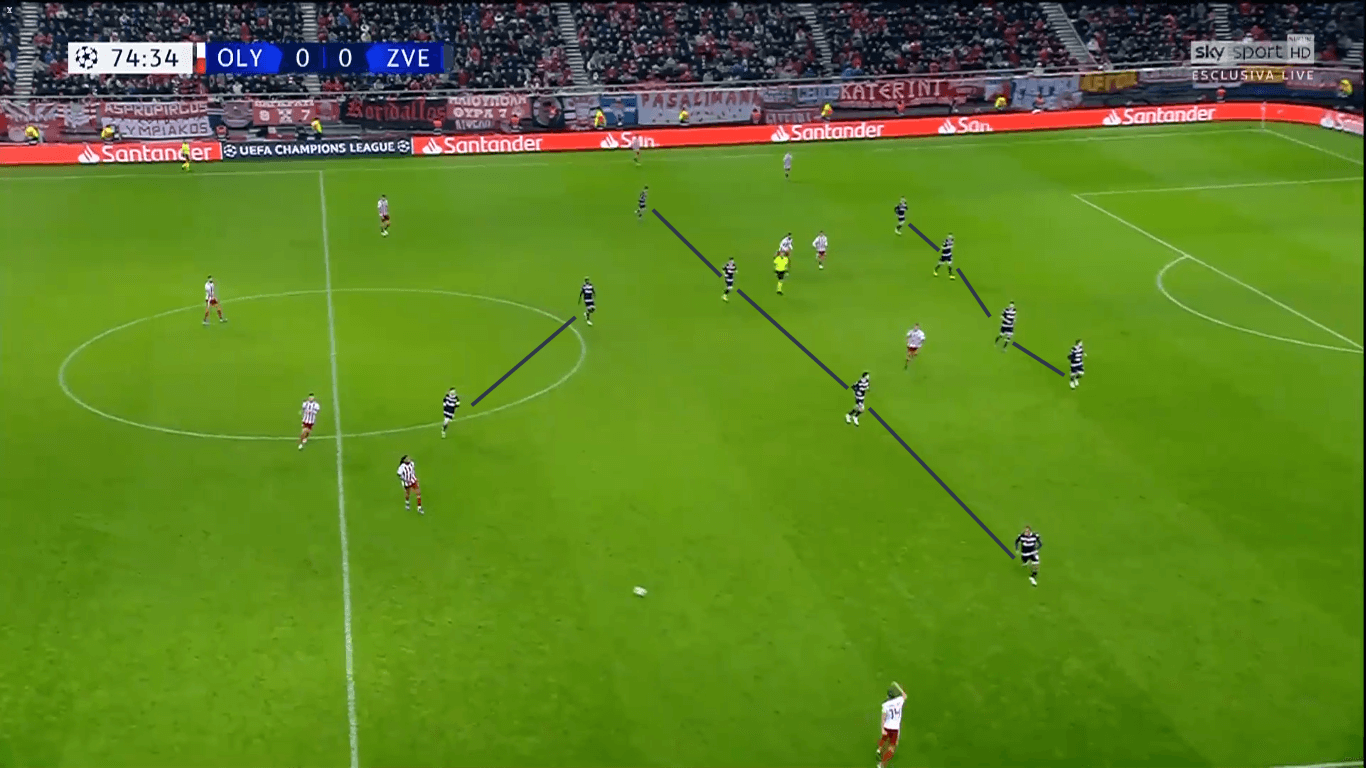
Although they varied through the game, they’ve always come back to their original setup, but with the last line narrower than usual so the wingers could drop lower and help them build more hybrid formations. Their block was mostly at the edge of dropping from central-oriented one to the low one with the idea of closing down the passing lanes towards the gap-positioned midfielders of Oly.
Red Star wanted to protect central and inner corridors so they allowed the opposition to move around the block sending balls to the flanks where they had the idea of double-teaming them with full-back-winger combo. Mateo Garcia and Andrija Vukanović did a great job providing defensive support so they constantly transformed their team’s structure into the 5-4-1 shape.
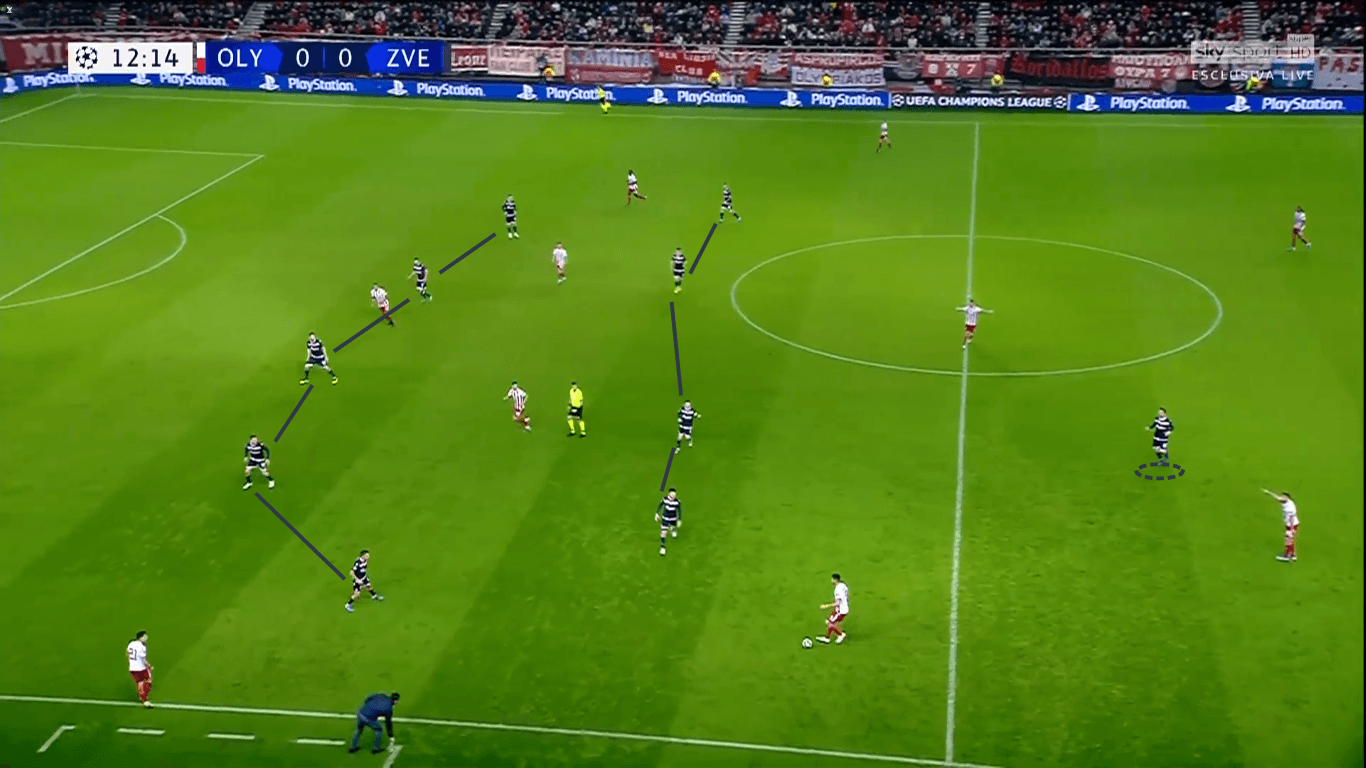
These settings made it possible for Crvena Zvezda to narrow the area of play and made it more difficult for their opponents to break through their lines. Wingers helped repeatedly and Olympiacos didn’t have many chances out of possessional actions when the visitors were set neatly, but there were some flaws in their shape from time to time so the hosts could benefit.
The biggest surprise from Milojević in this match was the idea of hybridising the 5-4-1 structure into the 6-2-2 formation in the same way they did in some qualifiers matches. That type of block demanded their wingers drop low and basically play as full-backs so the full-back position was “doubled”.
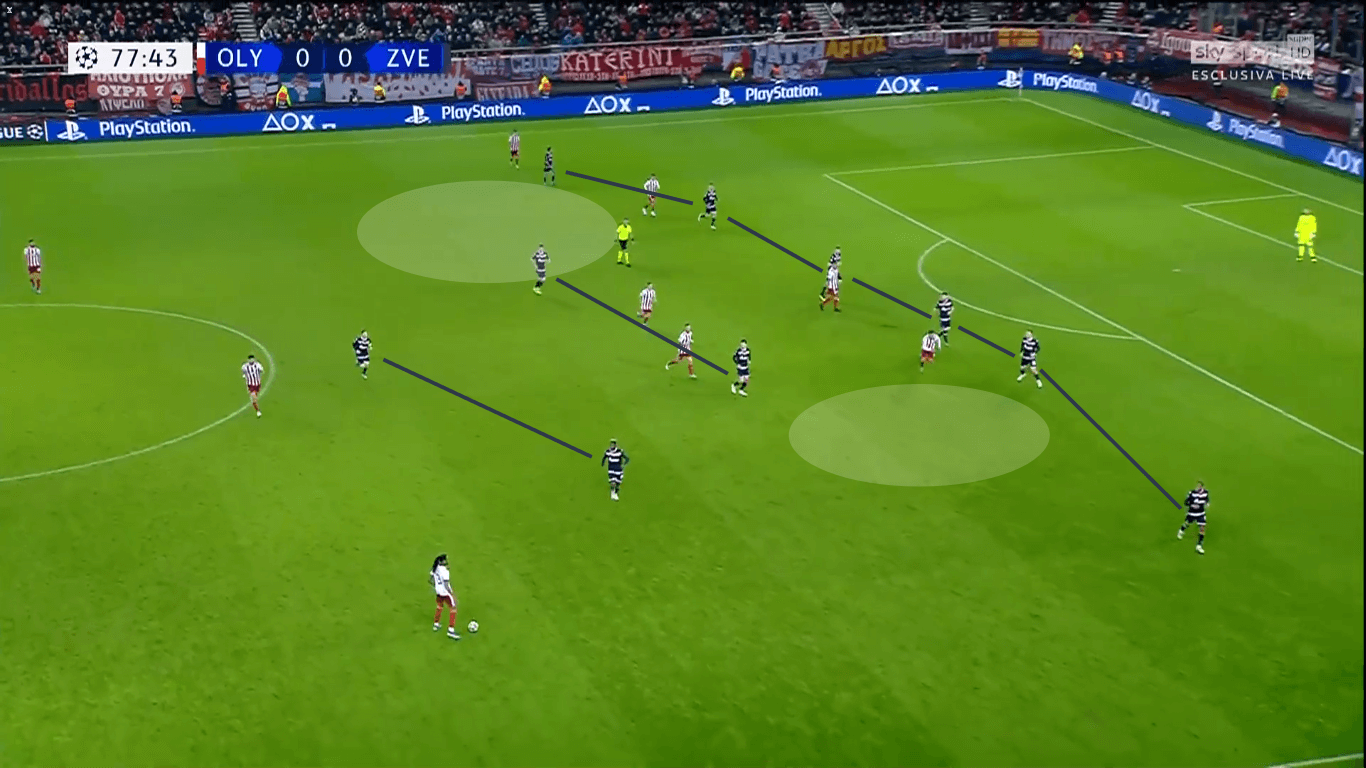
The six-men line moved Marko Gobeljić and Milan Rodić inwards and narrowed the initial last line of defence for them setting them in inner corridors to play as the third and fourth centre-back. That setup had its defects as the half-spaces were left free for the Greeks to exploit them, although they didn’t utilize on that fact very much.
Olympiacos’ neutralizing and way through
Both of the teams went highly physical in this clash as the stake was very high. Even though Red Star didn’t want the ball they tried to prevent the opposition of having fluid attacks with their sporadic pushes towards the goal and fake-pressures.
They had the idea of pressing from the central zone in order to not let Oly’s midfielders get the ball in the build-up phase. Milojević’s men man-marked them on their half of the pitch and tended to force the defenders to play it with long balls relying on their good in-the-air game.
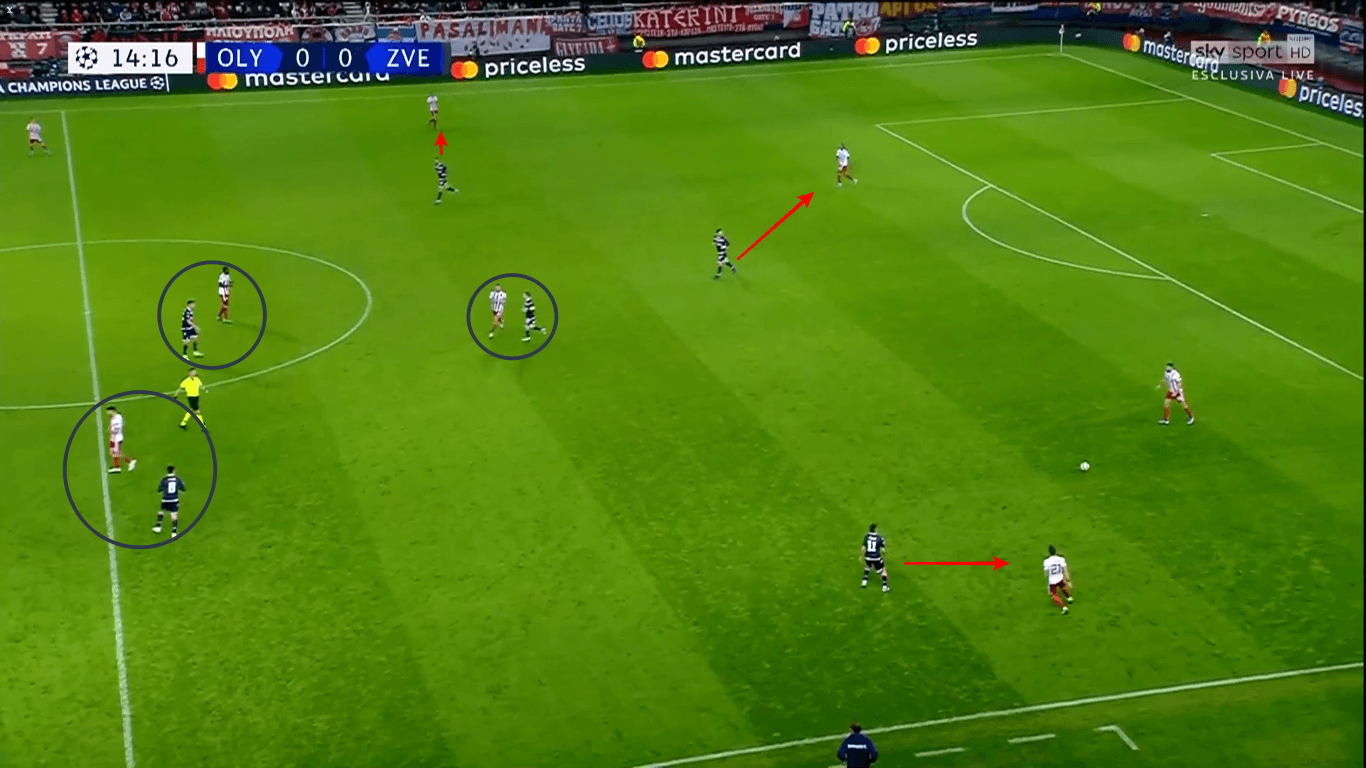
The away team’s midfielders did a good job staying close to their direct opponents and managed to neutralize them periodically, but that wasn’t the case all the time. Martins’ players kept their cool in those scenarios and were secure on the ball so they found the way to break the man-marking with midfield overloads.
Guilherme, Camara and Bouchalakis cooperated very well not panicking in the restricted areas and trying to get the ball when there wasn’t much free space around them so they won the battle in the central zone and sent the balls to the isolated full-backs next to the sidelines.
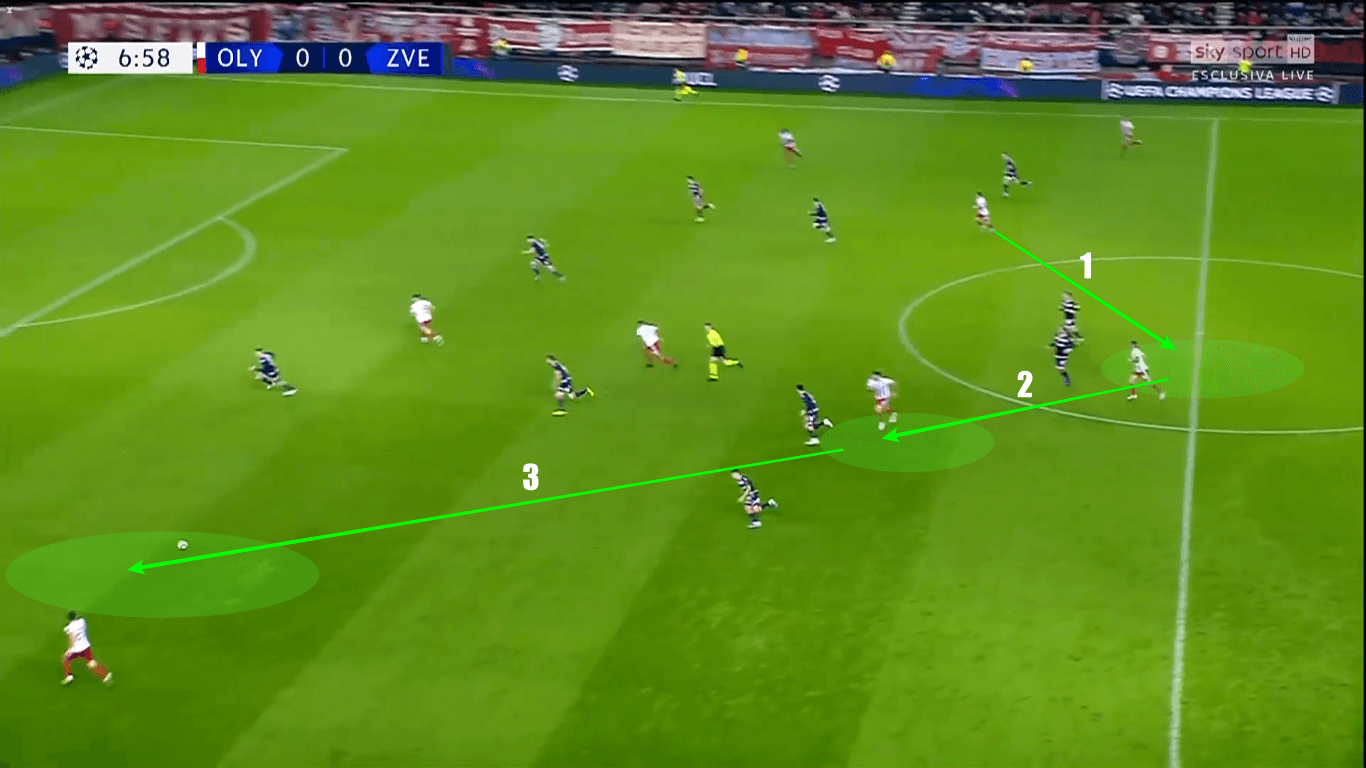
We can see the pattern of the ball movement in the Oly’s attacks in the picture above. They tended to move the ball in the midfield in order to disrupt Red Star’s well-drilled structure and then to pass towards the wide options. These scenarios mostly ended with crosses or return-passes, but Zvezda was very tight and played very bravely and they didn’t let them have a lot of chances out of them.
Greeks managed to skip the action and move forward, sometimes with their well-planned plays and sometimes with a bit of luck, but they were brilliant in cutting down the passing lanes to the visitors creative players and expelling their passing game out of the match. They were quite disciplined in the central block, moving like they are bonded with each other which enabled them to lock down opponent’s midfielders in the “cages” and force the defenders to play with long passes.
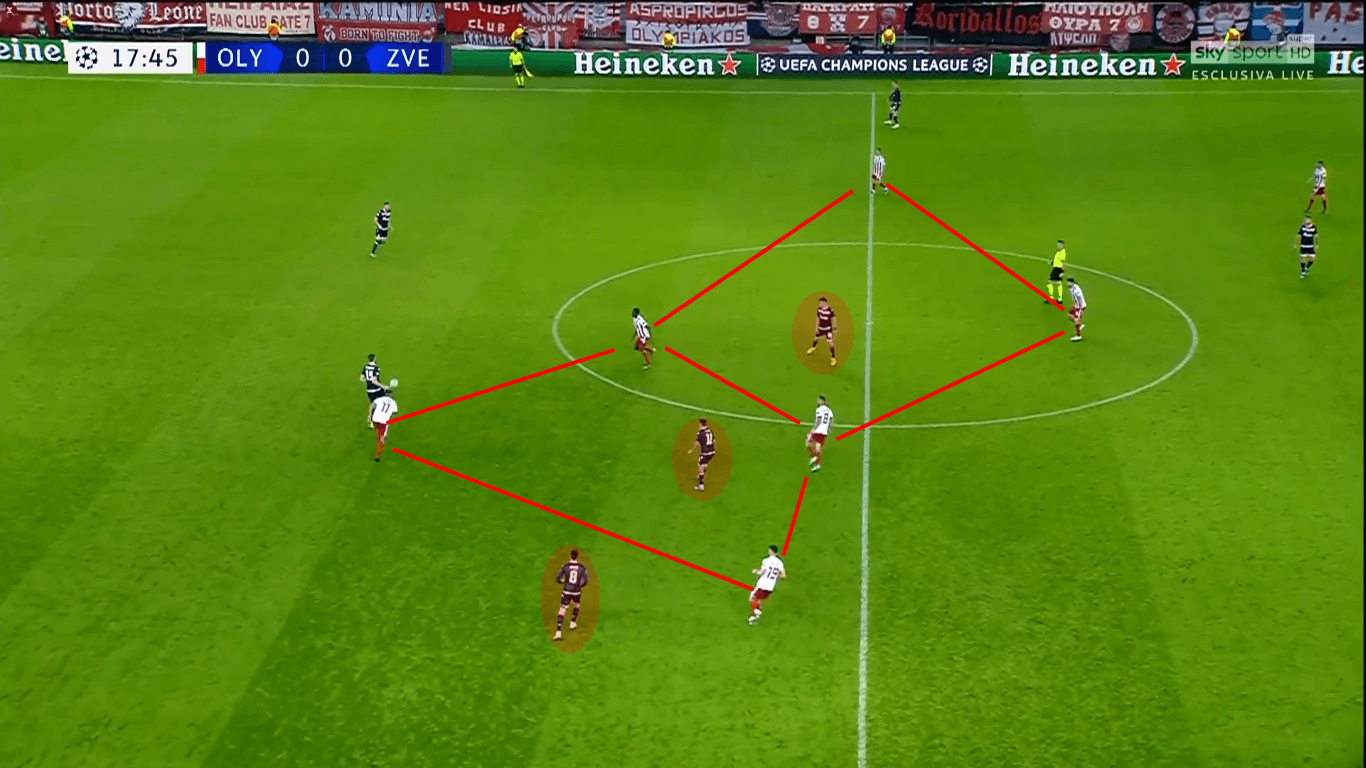
In the picture, we can see how Olympiacos’ organised structure looked like and how the creation was closed down for Crvena Zvezda, who, to be fair, didn’t want to play it in a possessional way. It needs to be said that the hosts created some goal-scoring opportunities from various settings, but Milan Borjan was brilliant at the away team’s goal and saved them in match plenty times.
Breaking Red Star’s lines
As the game matured, both teams became familiar with the opponents’ setups and managed to find the flaws that they could exploit. The away team stuck to their original idea of closing ways to their net and endangering the opposition through the fast-breaks and transitions, ending with them missing a penalty and having another few good chances to score.
Oly was controlling the game the whole time, being the better side and having a possessional dominance over the rivals. They succeeded in beating the pressure and block of Milojević’s men with their security on the ball and numerical superiorities in the restricted areas. Their idea was to provide support to the flank players who were left by Crvena Zvezda to freely receive the ball and to create surplus situations next to the sidelines after which they will switch the side of the action fastly.
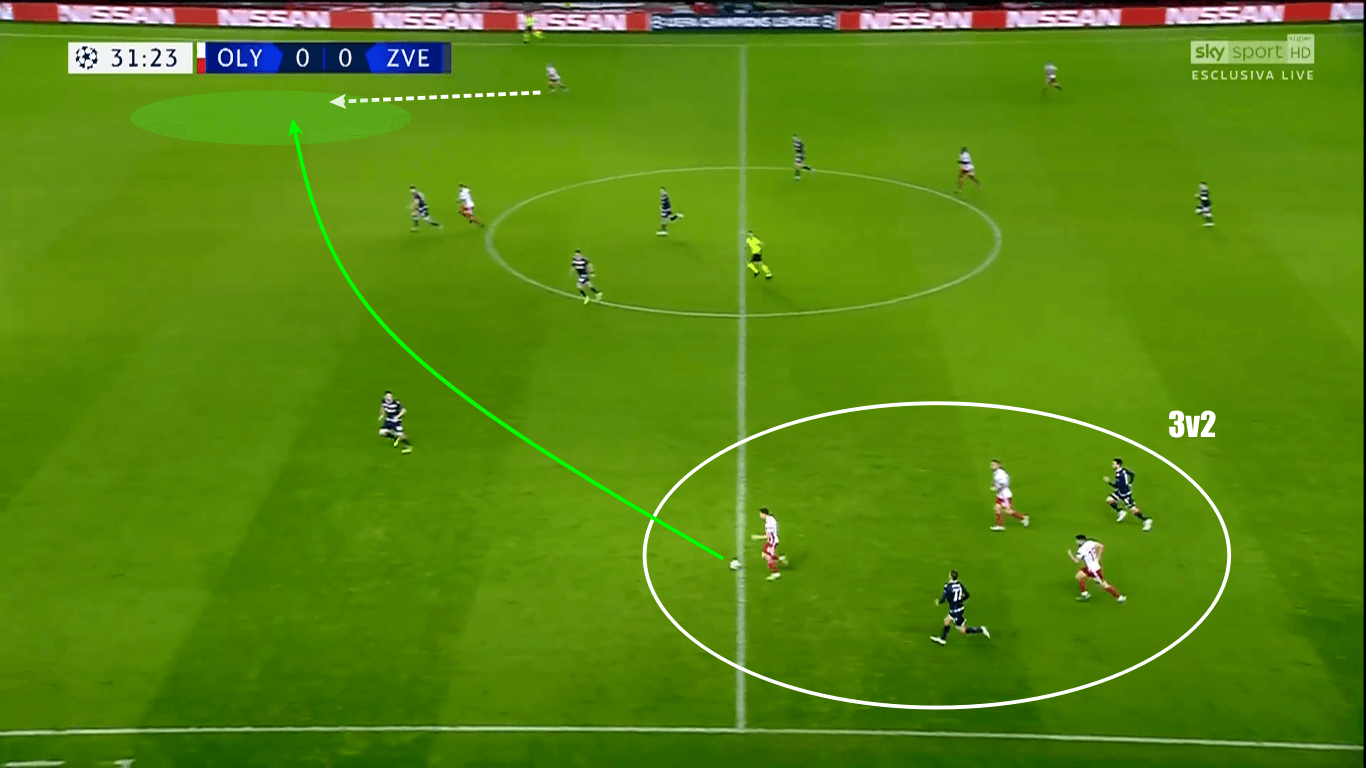
As it is shown above, Greeks used the numerical advantage they had in lower phase to move forward and attempted lots of diagonal passes in order to catch the opposition unprepared, before they set up their organised block.
We said that the of-the-ball structure of the visitors had its flaws and the home team found the way to exploit them from time to time. Camara was one of the bests in using the free room in the tight structure tending to search for the ball in the gaps between the midfield and defensive line of their opponents positioning in the blind spot of the direct guard.
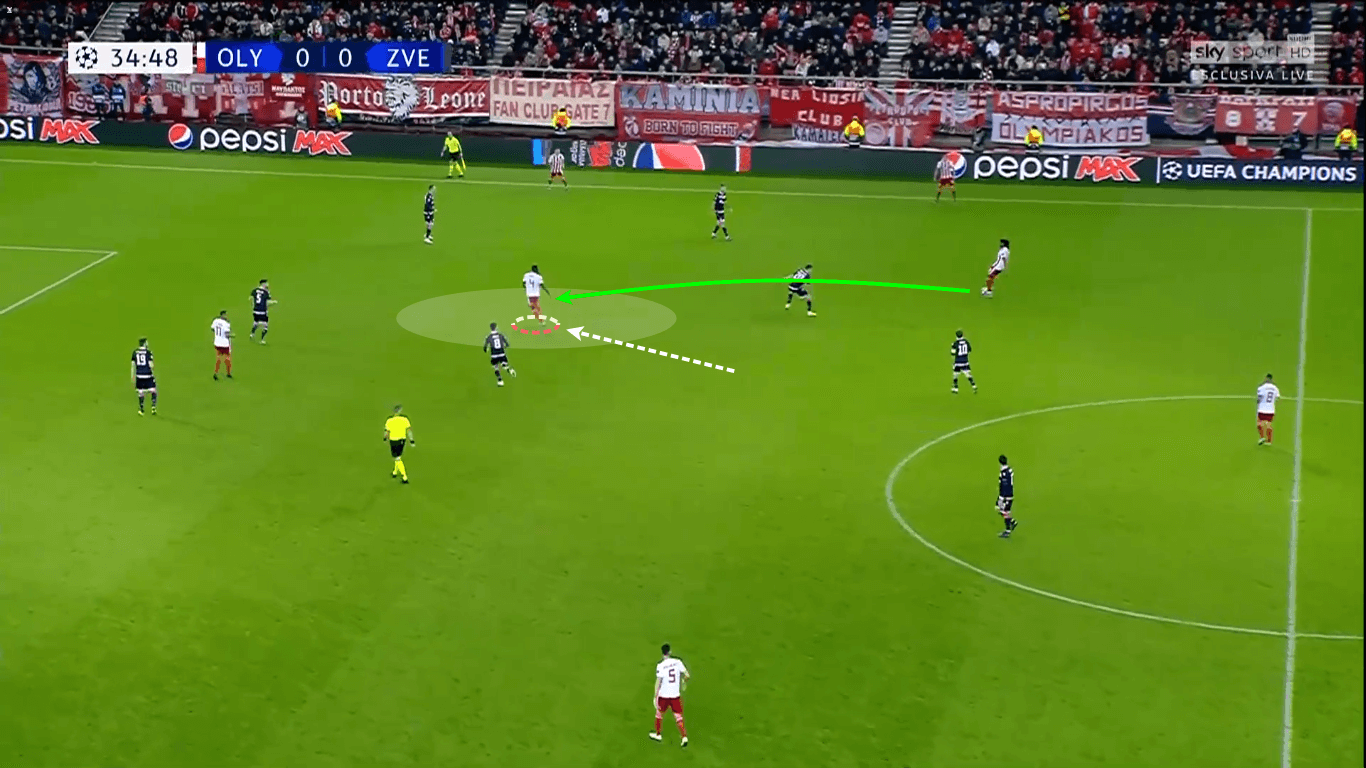
He profited on the basis of Ivanić’s bad defending and enabled his team’s progress. From those situations, Olympiacos could move forward and supply el-Arabi who was the greatest danger of their side.
Also, the home team sensed the bad communication between some of Zvezda’s players and tried to utilize it. The first idea they had was to pull the wide defender closer to the sideline, which resulted with a bigger gap between him and the centre-back who lacked in cooperation so the hosts repeated run-ins into these spaces from wing-positions.
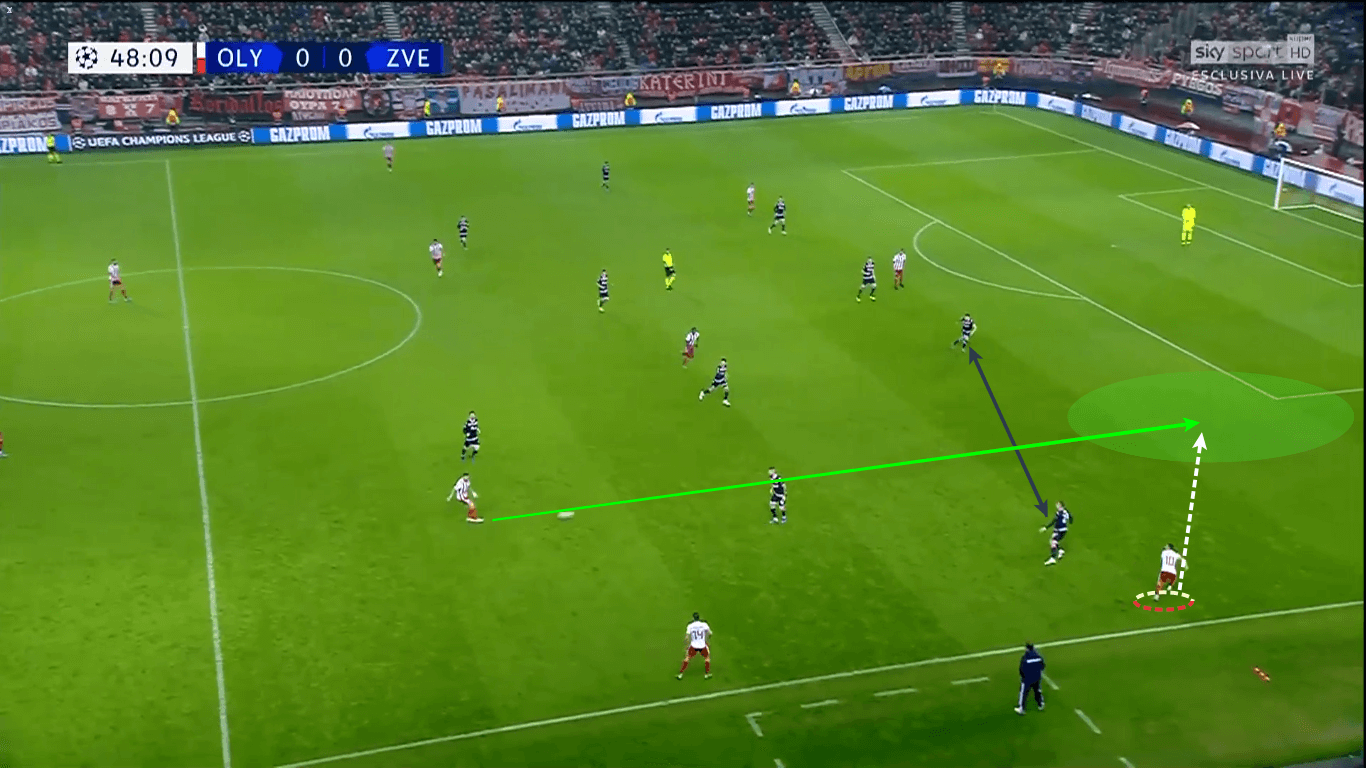
Full-backs and central defenders were often really close, but there were times when the distance between them was huge ergo Greeks had their chances out of it. Rodić and Gobeljić were disciplined in the biggest part of the duel but the entrance of Jander created problems for Red Star, resulting with him giving a penalty for the hosts in the closing stages of the match.
The same thing repeated between the two centre-backs, who didn’t succeed to bring the communication on the highest level throughout the whole season so it was seen as the possible way through Serbians’ defence. Although they stood close to each other, they aren’t that agile and fast so Olympiacos’ midfielders tried to supply their strikers with deep balls through the central corridor.
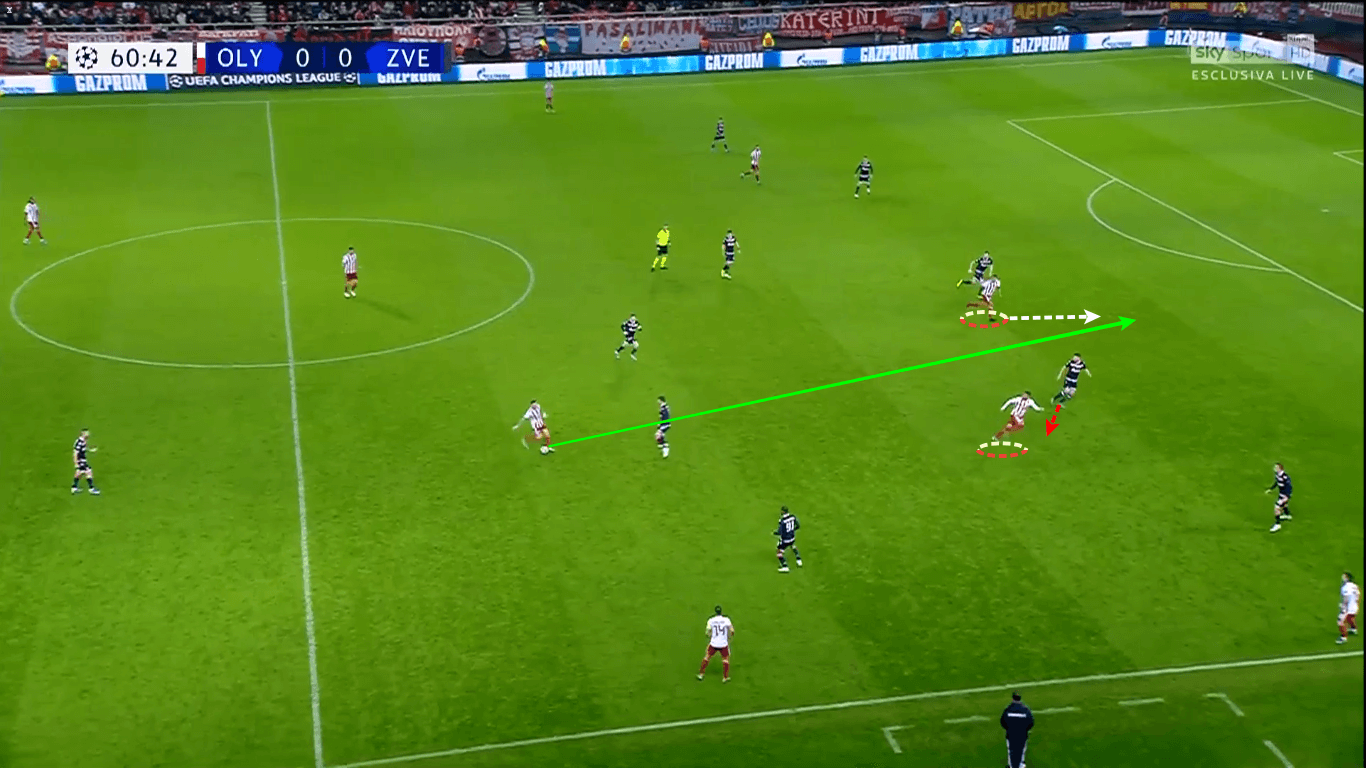
Miloš Degenek-Nemanja Milunović duo was again in their bad shape and had a lot of issues with the strikers, mostly because of bad corrections and positioning. This was the biggest problem for Crvena Zvezda in this year’s UCL campaign and the main reason they won’t participate in the “European spring”.
Conclusion
In this tough physical duel, Olympiacos was the better side as it was shown in the analysis. Red Star Belgrade’s struggle continued in this match once again, and even though they were more disciplined than they used to be in some past fixtures, they didn’t succeed in securing a positive result for themselves. The hosts controlled the action and deserved to go through, although they did that with a bit of luck in the last minutes.
Both of the teams are not on a Champions League level and the home team will need to work a lot in the winter if they want to play a bigger role in the Europa League’s knockout phase. Crvena Zvezda will start from scratches next year and will try to focus on the domestic league, but it is clear that they need some fresh blood – both in the roster and in the coaching staff.

If you love tactical analysis, then you’ll love the digital magazines from totalfootballanalysis.com – a guaranteed 100+ pages of pure tactical analysis covering topics from the Premier League, Serie A, La Liga, Bundesliga and many, many more. Buy your copy of the December issue for just ₤4.99 here





Comments